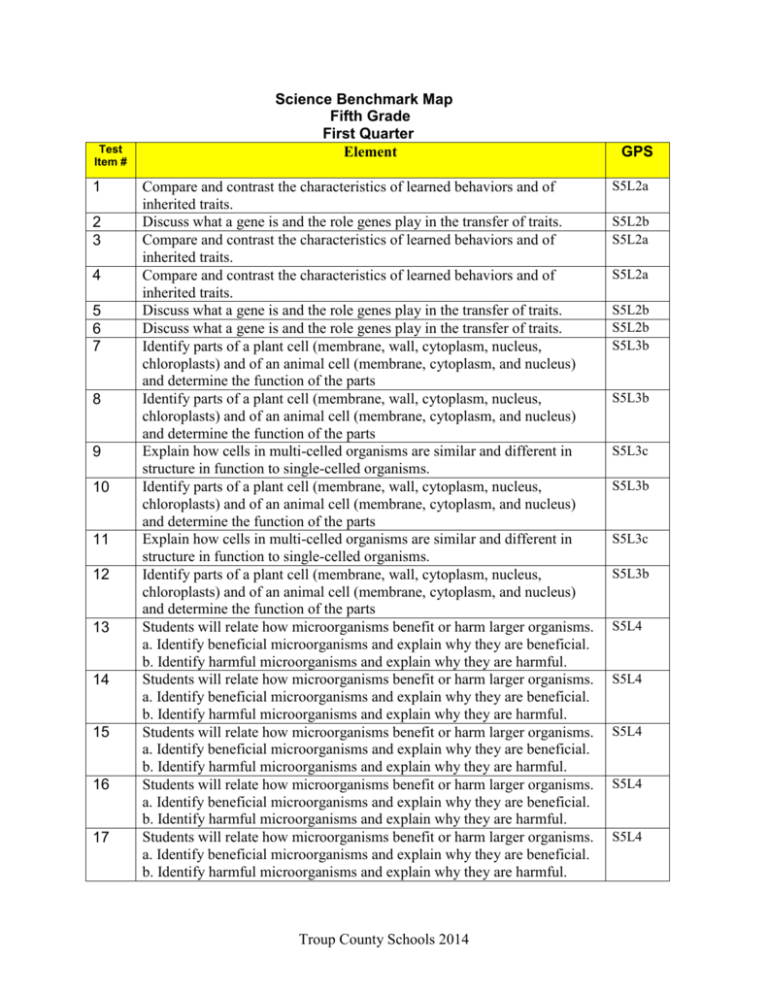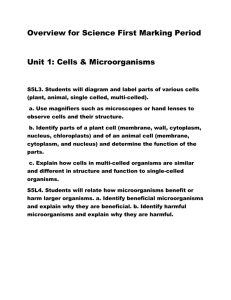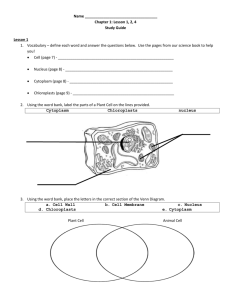Test Gate
advertisement

Test Item # 1 2 3 4 5 6 7 8 9 10 11 12 13 14 15 16 17 Science Benchmark Map Fifth Grade First Quarter Element Compare and contrast the characteristics of learned behaviors and of inherited traits. Discuss what a gene is and the role genes play in the transfer of traits. Compare and contrast the characteristics of learned behaviors and of inherited traits. Compare and contrast the characteristics of learned behaviors and of inherited traits. Discuss what a gene is and the role genes play in the transfer of traits. Discuss what a gene is and the role genes play in the transfer of traits. Identify parts of a plant cell (membrane, wall, cytoplasm, nucleus, chloroplasts) and of an animal cell (membrane, cytoplasm, and nucleus) and determine the function of the parts Identify parts of a plant cell (membrane, wall, cytoplasm, nucleus, chloroplasts) and of an animal cell (membrane, cytoplasm, and nucleus) and determine the function of the parts Explain how cells in multi-celled organisms are similar and different in structure in function to single-celled organisms. Identify parts of a plant cell (membrane, wall, cytoplasm, nucleus, chloroplasts) and of an animal cell (membrane, cytoplasm, and nucleus) and determine the function of the parts Explain how cells in multi-celled organisms are similar and different in structure in function to single-celled organisms. Identify parts of a plant cell (membrane, wall, cytoplasm, nucleus, chloroplasts) and of an animal cell (membrane, cytoplasm, and nucleus) and determine the function of the parts Students will relate how microorganisms benefit or harm larger organisms. a. Identify beneficial microorganisms and explain why they are beneficial. b. Identify harmful microorganisms and explain why they are harmful. Students will relate how microorganisms benefit or harm larger organisms. a. Identify beneficial microorganisms and explain why they are beneficial. b. Identify harmful microorganisms and explain why they are harmful. Students will relate how microorganisms benefit or harm larger organisms. a. Identify beneficial microorganisms and explain why they are beneficial. b. Identify harmful microorganisms and explain why they are harmful. Students will relate how microorganisms benefit or harm larger organisms. a. Identify beneficial microorganisms and explain why they are beneficial. b. Identify harmful microorganisms and explain why they are harmful. Students will relate how microorganisms benefit or harm larger organisms. a. Identify beneficial microorganisms and explain why they are beneficial. b. Identify harmful microorganisms and explain why they are harmful. Troup County Schools 2014 GPS S5L2a S5L2b S5L2a S5L2a S5L2b S5L2b S5L3b S5L3b S5L3c S5L3b S5L3c S5L3b S5L4 S5L4 S5L4 S5L4 S5L4 18 19 20 21 22 23 24 25 26 27 28 Identify parts of a plant cell (membrane, wall, cytoplasm, nucleus, chloroplasts) and of an animal cell (membrane, cytoplasm, and nucleus) and determine the function of the parts Identify parts of a plant cell (membrane, wall, cytoplasm, nucleus, chloroplasts) and of an animal cell (membrane, cytoplasm, and nucleus) and determine the function of the parts Explain how cells in multi-celled organisms are similar and different in structure in function to single-celled organisms. Students will relate how microorganisms benefit or harm larger organisms. a. Identify beneficial microorganisms and explain why they are beneficial. b. Identify harmful microorganisms and explain why they are harmful. Demonstrate how animals are sorted into groups (vertebrate and invertebrate) and how vertebrates are sorted into groups (fish, amphibian, reptile, bird, and mammal). Demonstrate how animals are sorted into groups (vertebrate and invertebrate) and how vertebrates are sorted into groups (fish, amphibian, reptile, bird, and mammal). Demonstrate how animals are sorted into groups (vertebrate and invertebrate) and how vertebrates are sorted into groups (fish, amphibian, reptile, bird, and mammal). Demonstrate how animals are sorted into groups (vertebrate and invertebrate) and how vertebrates are sorted into groups (fish, amphibian, reptile, bird, and mammal). S5L3b Demonstrate how plants are sorted into groups Demonstrate how plants are sorted into groups Demonstrate how plants are sorted into groups S5L1b S5L1b S5L1b Troup County Schools 2014 S5L3b S5L3c S5L4 S5L1a S5L1a S5L1a S5L1a








